ISSN ONLINE(2319-8753)PRINT(2347-6710)
ISSN ONLINE(2319-8753)PRINT(2347-6710)
M. T.Dewa1, S. Mhlanga2 L. Masiyazi3, D. Museka4
|
| Related article at Pubmed, Scholar Google |
Visit for more related articles at International Journal of Innovative Research in Science, Engineering and Technology
Delivery reliability and responsiveness are key competitive performance goals for manufacturers in the bakery industry. The firm loses market share and customer goodwill when orders are delivered late. However, orders which are produced earlier than the due date attract high inventory holding costs. This paper presents the design of a Finite Capacity Scheduling System (FCSS) for optimum sequencing of daily bakery orders at a local bakery in Zimbabwe. The main objective of the FCSS was to generate a schedule that minimized the penalties caused by the late delivery and early production of a set of final orders. The system was a simulation-based tool capable of capturing real-time data of the resource status and order schedules so as to generate the optimum schedule based on the comparison of five heuristic sequencing rules using a basis objective function. The system established the optimum schedule for the defined set of orders before they were launched onto the shop floor and posted the results to an external excel spreadsheet for analysis and decision making by stakeholders.
Keywords |
| Finite Capacity Scheduling, Simulation |
I. INTRODUCTION |
| Offering good service for customers involves many different relations between a firm and its clients. In most markets, customers are won through a company’s ability to supply an order on the agreed customer due date (delivery reliability) or their ability to supply orders quicker than competitors (delivery speed). Companies that compete in this way need a manufacturing process, which can respond to this requirement. This means if a firm continues to miss it’s promised due dates, customers will increasingly stop considering them as potential suppliers. However, the scarcity of resources on the shop floor is a reality all manufacturers face during daily production operations. Due to unforseen real-time events, machines can be rendered unavailable and raw materials may run out making the planning of operations more difficult and delaying the production of awaited orders. Hence, job orders should be scheduled so that available capacity is utilized in an optimal manner. To achieve this goal, researchers have advocated for the use of Finite Capacity Scheduling systems. Interest in the use finite capacity scheduling systems has increased among researchers and industrialists who are motivated with the desire to meet customer demand in a timely fashion so as to use customer service as a competitive weapon. This paper presents the design of a finite capacity scheduling system for Lobels Bread, one of the largest bakeries in the nation of Zimbabwe. The developed system can also be used in similar flow shop manufacturing systems successfully. |
| The organization of the paper is as follows: firstly a review of the different finite capacity scheduling approaches; then an outline of operations for the case study and finally the FCSS is presented, together with obtained results from experiments before concluding and citing recommendations. |
II. RELATED WORK |
| Wuttipornpun et al [1] developed an algorithm of finite capacity material requirement planning (FCMRP) system for a multistage assembly flow shop. The first stage was to allocate operations to the first and second priority work centers and also determine the sequence of operations on each work center, whilst the second stage was to determine the optimal start time of each operation using linear programming. The proposed system offered an adjustable solution and results showed the combination of FCMRP NP 3 and (Earliest Due Date) EDD outperformed other combinations in terms of overall performance index. Lehtonen et al [2] presented an application of a simulation-based finite scheduling at Albany International, which was the largest manufacturer of paper machine clothing in the world. The study done indicated that a simulation based solution was a viable option especially when the production process did not include material combinations and there was adequate local sequencing. Novels and Jonik [3] described the use of capacity planning and scheduling decision support tools that combined a simulation model generated with ARENA and PREACTOR a PC based finite scheduling software. The combination was used in a food processing plant in order to investigate how they might influence variable costs. |
III. FINITE CAPACITY SCHEDULING APPROACHES |
| The capacity of a production system refers to the amount of output it can produce in a given time period while utilising available resources. Resources in this case refer to the equipment and personnel which are utilised for the value addition processing or transfer of system entities (raw materials, work-in-progress and final products) such as machines, operators and transporters. Scheduling refers to the assignment of start and end times for all manufacturing activities and deciding which tools or machines will build the parts in line with the process plan [4].According to [5], Finite Capacity Scheduling (FCS) is the optimal assignment of limited resources to tasks (activities) to fulfil a set of orders. Finite Capacity scheduling in manufacturing planning has being well-known for a long time in different manufacturing systems. The way of generating the optimal schedule varies. Many different applications have been developed to solve a variety of scheduling problems while various approaches have been used to come up with a good schedule. |
| A. Simple Heuristic rules Approach |
| Early scheduling systems used simple priority dispatch rules forming a deterministic method whereby orders are not scheduled until certain constraints had been fulfilled. Dispatching rules are a common means of scheduling due to their simplicity, swiftness and inevitability when arriving at a solution [6]. Transaction processing oriented Enterprise Resource Planning and Materials Resource Planning-based solutions are known to apply to infinite schedules. In the systems presented by [7] the schedule was generated using heuristic rules. Musselman et. al. [8] chose the orders that can be completed within the given time frame. |
| B. Algorithm and search Approaches |
| Searching algorithms have also being employed in generating optimum scheduling problems. Linear programming was employed by[9]and while[2] used a search algorithm based on branch and bound for creating a preliminary schedule, giving precise start and end times for vents while identifying potential challenges. |
| C. Simulation-based Approach |
| Simulation based production scheduling approaches have recently emerged as alternatives solutions for finite capacity scheduling. The simulation approach allows for the modelling of system complexity hence providing the ability to capture a great level of detail about the system under study. According to [9], historical data generated from a simulation run of a factory can be used to evaluate the best scheduling approach. In a study on the scheduling of airport operations, [2] stated that a simulation model is a suitable tool for scheduling operations they since they can reckon a lot of detail as is necessary to capture the dynamics of the production system. The approach is applicable to forward scheduling problems in a flow shop environment. The usefulness of simulation lies in the ability to evaluate different schedules, detect and prevent problems before the detailed schedule can be implemented by the manufacturing function [10]. In the case described in this paper, simulation is used for optimal schedule generation and selection. Different heuristic rules are compared in a simulation run. The simulation system uses real time data on system availability and current orders derived from an external database and files. The output of the system was posted to an excel spreadsheet. |
IV. LOBELS BREAD CASE STUDY |
| Lobels Bread manufactures and markets quality bakery products, which include bread, buns and scones. The firm is one of the nation’s leading providers of confectionery products. One of Lobel’s manufacturing sites is located in Bulawayo, Zimbabwe. Different recipes are used in the manufacturing process for all the products are almost similar making it easy to implement Group Technology techniques. The production environment is a flow shop set up. |
| A. Production Process |
| The manufacturing process is mainly batch-line because it is providing similar products (bakery products) on a regular repeat basis and consists of multiple workstations and machines. The plant operates on a semi - automated flow-line which is monitored by only eight operators. The process flow diagram shown below in Fig 1 clearly shows the sequence of stages in the baking process. |
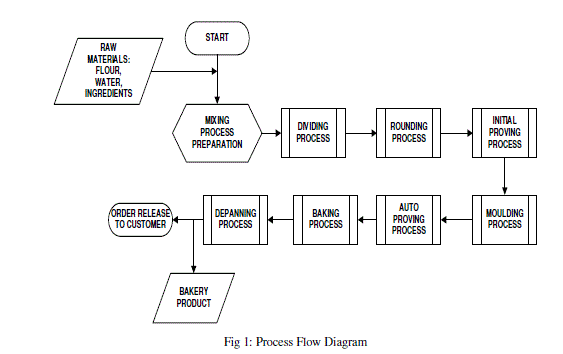 |
| There are two main stations in the plant, which are the kneading station and the baking section as shown in the work flow diagram in Fig 2 below. The processes at the kneading station are: mixing, dividing, rounding, moulding and pan proofing. The baking process is the only process, which occurs in the oven. The first step involves the weighing of the ingredients to be mixed. Water temperature is important in controlling the dough temperature. To achieve dough temperature control during the mixing the following factors must be known and applied: |
| Desired dough temperature at completion of mixing |
| Available water temperature |
| Kilograms of water in the formula |
| Temperature of mixing room (plant) |
| Temperature of floor |
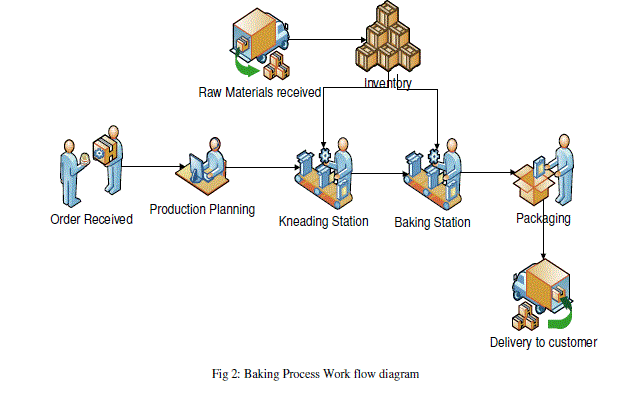 |
| Mixing of the dough is done to evenly distribute the yeast cells throughout the dough and develop the gluten. The dough is then cut into loaf, bun or scone size pieces using a divider before weighing of the pieces to ensure uniformity. The divider consists of a camshaft carrying various cams controls through linkages, the movements of the knife and the ram. A clutch in the gear box at the front of the divider, under the conveyor, allows the machine to be engaged or disengaged from the main drive. The handle of the clutch must be removed before opening the clutch box door. The gear reduction ratio is 53/21. The process time of this process is a variable which is a function of the order quantity and the type of product being produced (bread, buns or scones).The last process after the kneading procedures is the baking task. This process occurs in the oven. The order quantity does not affect the baking time since the units are baked in batches. |
| B. Manufacturing resource requirements |
| The principle function of a manufacturing process is to convert inputs (labour, energy, and raw materials) into a final product that is marketable. Fig 3below is a representation of the resources used and the tasks conducted during a baking process. |
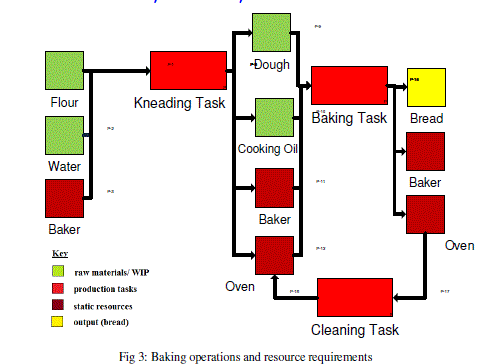 |
| The utilized resources are divided into two classes: Renewable resources and unrenewable resources. The renewable resources in this model are the baker and oven. Renewable resources are restored after the manufacturing process hence there have two states which are available or not available during the process. One task consumes these resources and restores them at the end of the task. The unrenewable resources are consumed during tasks and in the process shown above, they include: Flour, water, cooking oil and dough. Dough that is a mixture of flour and water is regarded as work in progress. The baking process has only three operations, which are: kneading, baking and cleaning. The cleaning operation is a changeover task or set up for a new process. |
| C. Finite Capacity Scheduling System Objectives |
| Satisfying customer demand on time is our main focus area in this paper. The objectives to achieve this goal are: |
| Conforming to due dates |
| Maximizing throughput |
| Minimizing work in progress and order flow time |
| Maximizing resource utilization |
| The scheduling problem at Lobels involved the selection an optimal schedule that will fulfil the above given objectives given the constraints for available resource capacity, resource availability, labour calendar and machine maintenance calendar. An objective function for computing the lateness penalty for each order was developed. |
| D. Mathematical Model Formulation |
| Minimizing the penalties caused by both the early completion and late delivery of orders, whilst simultaneously considering available capacity is the objective. The formulated function aggregated a penalty cost for both earliness and tardiness. The optimum solution was deemed to achieve a minimum total cost: |
| Minimize total costs = Σ Earliness costs + Σ lateness costs |
 |
| V. EXPERIMENTAL DESIGN |
| A simulation model which is a valid representation of the manufacturing process was designed. Data for the model on the expected orders, resource constraints and labour breaks was extracted from an external database and excel spreadsheet. Rockwell Arena 14.0 was used to design the simulation model while Microsoft Access and Excel software were employed to create the databases which contain the order status, system definition and the product definition. |
| A. Dispatch Rule Scenarios |
| The order sequence with the lowest penalty was deemed the best. Five dispatch rules were evaluated in the study. These were: |
| Earliest Due Date (EDD) |
| First Come First Serve (FCFS) |
| First In System Last Serve (FISLS) |
| Shortest Processing Time (SPT) |
| Random (RAN) |
VI. SYSTEM ARCHITECTURE |
| The structure of a simulation scheduling system is shown below in Fig4. Input information, which includes a system definition (current resource status), a product definition (product range and processes) and a list of actual customer orders, is defined in external files. |
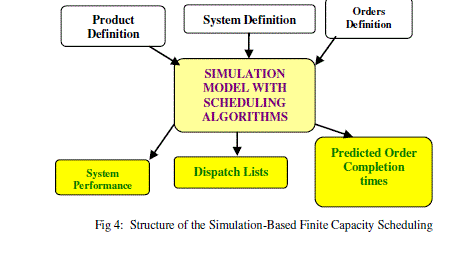 |
| A. System Inputs |
| From the architecture presented above, the user of the system enters parameters of the current orders, resource status and products to be done. |
| 1) Product Definition |
| The purpose of this file was for specification of the process routes and processing times for each product manufactured at the bakery. This ensures selection of the relevant route for a product selected. The product range at Lobels includes confectionery products which consist of bread, scones, buns and cream doughnuts. |
| 2) System Definition |
| The current capacity levels of available resources of the shop floor are captured in an excel spreadsheet linked to the simulation model. Table 1 below shows the spreadsheet with the names of the resources utilized. |
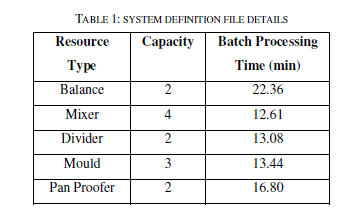 |
| 3) Order Definition |
| The purpose of this file was for the capturing of current production orders received from customers. The designed system was tested using data of five orders collected on within a specific period. The set of orders shown in Table 2 below were used to demonstrate the functionality of the system. |
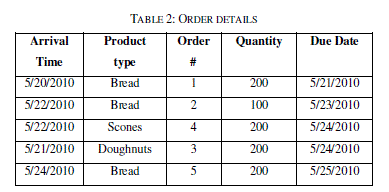 |
| The table above shows data for five Orders which arrived at different times on the same day. Database queries were utilized to adjust the order sequences based on the heuristic rules stated in the experimental design phase. |
| B) Simulation Logic |
| The simulation model uses the data captured in the input files and contains different scheduling rules. Since all the data about the system is stored in an external repository, the system user can adjust the scheduling scenario without affecting the validity and structure of the model logic. The simulation model logic which is the heart of the system is shown below in Fig5. |
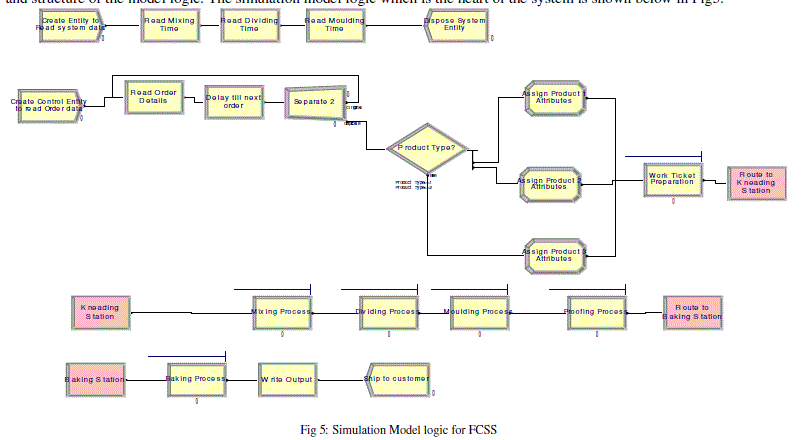 |
VII. RESULTS |
| For the set of orders, the simulation model computed the throughput time for each order and penalty for lateness calculations were used to determine the optimal schedule. The outputs sent to a database included order completion times, dispatch lists and system performance statics. The objective was to determine the throughput for each order so as to observe the lateness of each order. Table 3 below displays the rests collected for a specific scenario of five orders. |
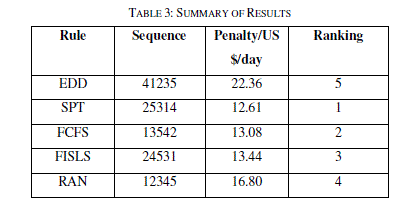 |
| The EDD sequence is the optimal schedule of the five. Each scenario may yield a different optimal schedule rule. Furthermore, the system reckoned information on the resource utilization. |
VIII. CONCLUSIONS AND RECOMMENDATIONS |
| The paper concentrated on delivery responsiveness as it relates to the customer’s order. In this sense, better customer service is characterized by offering competitive lead-times, dealing with Just-in-Time quantities and responding when customers change items, quantities or dates. The designed finite capacity scheduling system designed was used as decision support tool to help production planners on how to sequence orders. The usefulness of the developed system is in its ability to plan ahead and prevent any potential problems from occurring before the detailed production schedule is implemented by the plant. Future research can be done in using the same tool for applications which facilitate short-term sequencing, exception scheduling and long range planning. |
ACKNOWLEDGEMENTS |
| The researchers wish to acknowledge Lobels Company and other contributors who helped towards developing data for the case study material. |
References |
|